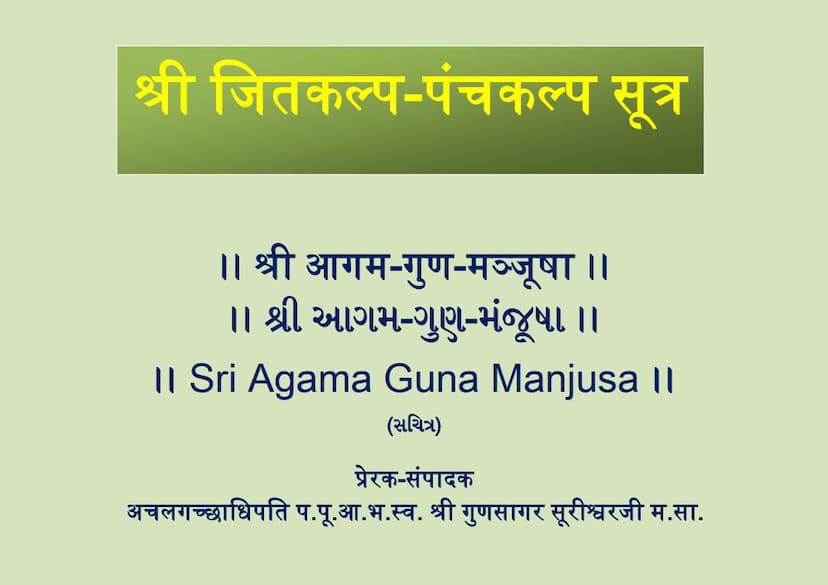Agam 38 Chhed 05 Jitkalpa Sutra Shwetambar Agam Guna Manjusha
Added to library: September 1, 2025

Summary
Summary of Agam 38, Chhed 05, Jitkalpa Sutra (Shwetambar Agam Guna Manjusha)
This Jain text, "Agam 38 Chhed 05 Jitkalpa Sutra" from the "Agama Guna Manjusha" series, compiled by Gunsagarsuri, provides a detailed overview of the Jain Agamas, focusing on the six Cheda-sutras. The text is presented in a way that introduces the various classifications of Agamas and then delves into the specifics of each, particularly highlighting the significance of the Cheda-sutras.
Overall Structure and Content:
The book is structured as a comprehensive introduction to the 45 Agamas, categorizing them into:
-
Eleven Angas (Primary Scriptures): These are the foundational texts. The book briefly describes each Anga, including its subject matter, number of lessons, and approximate number of verses. Key Angas mentioned include:
- Acharanga Sutra: Deals with the conduct of monks and lay followers.
- Suyagadanga Sutra: Discusses various philosophical views and doctrines.
- Sthana Sutra: Touches upon calculation and other teachings.
- Samavaya Sutra: A compendium of various objects.
- Vyakhya Prajnapti Sutra (Bhagavati Sutra): The largest Anga, featuring question-and-answer sessions between Lord Mahavira and his disciples.
- Jatadharmakatha Sutra: Narrates religious discourses and stories.
- Upasaka Dasanga Sutra: Discusses the twelve vows and the lives of ten great lay followers.
- Prashna Vyakarana Sutra: Answers questions posed by various beings.
- Vipaka Sutra: Narrates stories of both virtuous and sinful actions and their consequences.
-
Twelve Upangas (Subsidiary Scriptures): These texts further elaborate on the Angas. Examples include:
- Aupapatika Sutra: Related to Acharanga Sutra, describing the city of Champa and austerities.
- Raiapraseniya Sutra: Related to Suyagadanga Sutra, mentioning King Pradesi.
- Jivabhigama Sutra: Related to Sthana Sutra, analyzing soul and non-soul entities.
- Prajnapan Sutra: Related to Samavaya Sutra, detailing 36 steps.
- Surya Prajnapti Sutra and Chandra Prajnapti Sutra: Discussing astronomical calculations.
- Jambudvipa Prajnapti Sutra: Describing the continent of Jambudvipa.
- Nirayavali Sutra: Narrating stories related to hellish beings.
- Kalpavata Sutra: Life sketches of princes.
- Pushpika Upanga Sutra: Topics of various celestial beings.
- Pushpachulika Sutra: Previous births of goddesses.
- Vrushni Dasha Sutra: Stories of the Vrushni dynasty.
-
Ten Prakirna Sutras (Miscellaneous Scriptures): These cover a variety of topics. Examples include:
- Chatuḥsharan Prakirna Sutra: Describes the four refuges.
- Atura Pratyakhyana Prakirna Sutra: Deals with final practices.
- Bhakta Parigraha Prakirna Sutra: Discusses types of death.
- Samstara Prakirna Sutra: The glory of Samstara (a specific ascetic practice).
- Tandula Vichara Prakirna Sutra: Detailed information on food consumption over a lifetime.
- Devendra Stava Prakirna Sutra: Hymns to celestial beings.
- Marana Samadhi Prakirna Sutra: Detailed description of practices related to death.
- Mahapratyakhyana Prakirna Sutra: Practices for monks at the time of death.
- Ganividya Prakirna Sutra: Summary of astrological treatises.
-
Six Cheda-sutras (Shat Cheda Sutras): These are the primary focus, dealing with serious discussions on conduct, exceptions, and penances. The text emphasizes the exclusivity of studying these for highly qualified monks. The six Cheda-sutras are:
- Nishitha Sutra
- Mahanishitha Sutra
- Vyavahara Sutra
- Jitakalpa Sutra (This is the central text being described)
- Panchakalpa Sutra
- Dasha Shruta Skandha Sutra
-
Four Mala Sutras (Mala Sutras): These are considered essential for monks and nuns. Examples include:
- Dashavaikalika Sutra: Described as a lake of nectar for ascetics.
- Uttaradhyayana Sutra: Lord Mahavira's last sermons.
- Anuyogadvara Sutra: Considered the key to all Agamas, explaining different interpretative methods.
- Avasyaka Sutra: Describes six essential daily duties for all Jain followers.
-
Two Chulikas (Appendices/Supplements):
- Nandi Sutra: Contains hymns, names of Tirthankaras and Ganadharas, and information on the five types of knowledge.
- Anuyogadvara Sutra: (Also listed under Mala Sutras, indicating its multifaceted importance).
Focus on Jitakalpa Sutra (Agam 38 - 1):
The text specifically details the Jitakalpa Sutra. It is described as containing 103 verses (Gathas). The content includes:
- Initiation with devotional salutations (Deshna-Vandana).
- A brief description of penance (Prayashchitta).
- The importance of penance and its ten types.
- Discussions on confession (Alochanā) and returning to practices (Pratikraman).
- Appropriate faults for Viveka (discrimination) and Vyutsarga (abandonment) penances.
- Penances for infractions related to knowledge (Jnana-ati-char), perception (Darshana-ati-char), and the five great vows (Pancha Mahavrata).
- Penances related to various austerities (Tapa) based on substance (Dravya), place (Kshetra), and time (Kala).
- The ritual of the Jitakayantra (a mystical diagram).
- Penances based on re-observation (Pratishevana).
Focus on Panchakalpa Sutra (Agam 38 - 2):
The text notes that the original Panchakalpa Sutra is not currently available, and its commentary is what is published. This scripture discusses:
- The conduct of monks.
- The penances of the five Kalpas (likely referring to specific rules or practices).
- Discussions on confession penances for both the honest and the deceitful.
- Re-initiation into the order after leaving.
- Penances for repentant individuals, those who are angry, proud, or afflicted by obstacles (Upsarga).
- Criteria for conferring the titles of Acharya and Upadhyaya.
- Penances for mendicants who move alone (Eka Vihari).
- Limitations of Vanadana (salutation) and Vihara (wandering).
- Actions to be taken if bitten by a snake.
- Victory over passions (Mohavijaya).
- The five great virtues (Pancha Atishayas) of an Acharya and Upadhyaya.
- The importance of study (Swadhyaya) and reading (Vachana).
- The fruits of various types of acts of service (Vaivachayya).
Key Themes and Significance:
The "Agama Guna Manjusha" series, particularly this volume focusing on the Jitakalpa Sutra, serves as an educational resource for understanding the vast body of Jain scriptures. It highlights the intricate details of monastic discipline, penance, and the classificatory systems within Jain Agamas. The emphasis on the Cheda-sutras underscores their gravity and the strict qualifications required for their study and practice, reflecting the rigorous path of Jain spiritual discipline. The text also implicitly emphasizes the importance of adhering to the prescribed rules and penances for purification and spiritual progress.